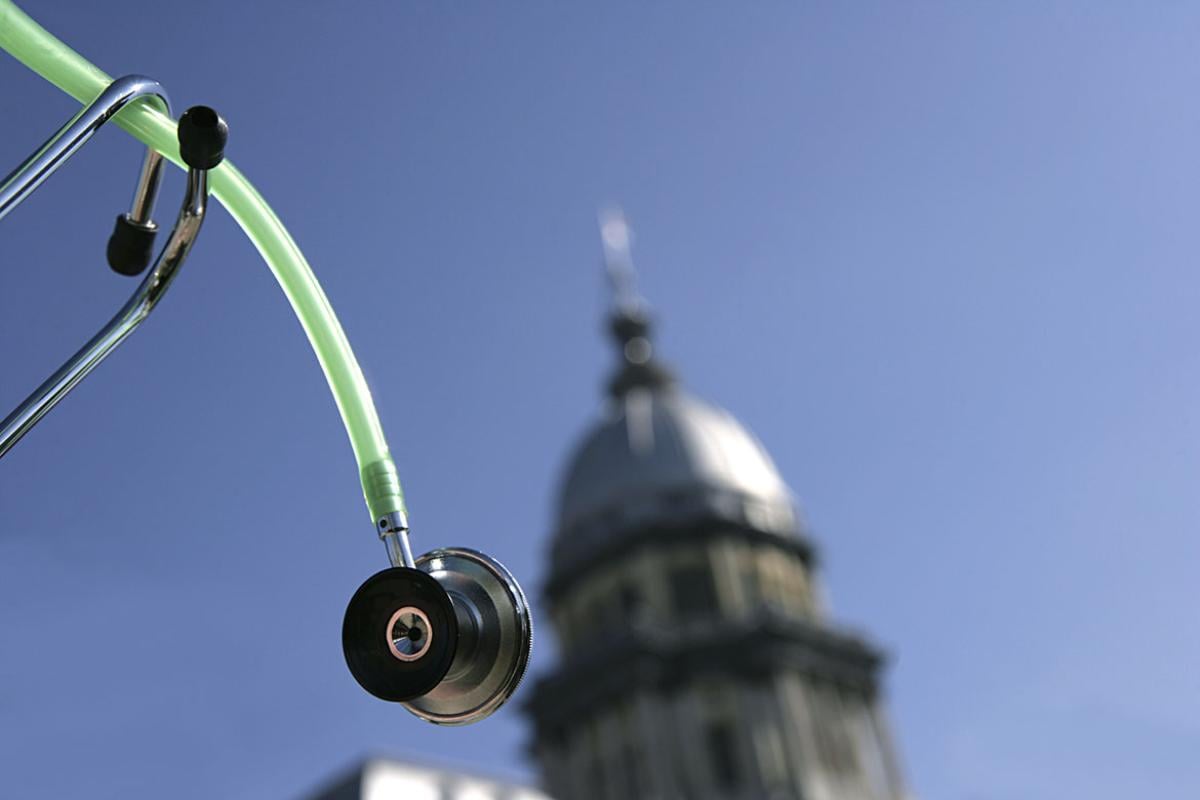Known as the “forgotten valve” in cardiology circles, the tricuspid valve is finally getting its due.
Unlike aortic and mitral valve diseases, tricuspid valve problems historically haven’t received as much attention in terms of research, innovation and advancement. While tricuspid valve disease does not have as high a mortality rate as severe aortic stenosis or severe mitral valve regurgitation, patients living with it suffer tremendously, with poor quality of life.
“People can start to feel just awful with tricuspid valve regurgitation,” said Tiberio Frisoli, MD, medical director of the Center for Structural Heart Disease and senior staff physician of interventional cardiology at Henry Ford Health in Detroit. Henry Ford Health is a member of the AMA Health System Program, which provides enterprise solutions to equip leadership, physicians and care teams with resources to help drive the future of medicine.
“Patients can be fatigued, their legs can be swollen like tree trunks, their kidneys and liver can become congested and fail, and they can feel short of breath with daily activities such as walking,” he added.
Tricuspid valve disease causes these symptoms and outcomes because when the tricuspid valve doesn’t close properly, blood leaks back into the right atrium. This can cause a decrease in the efficiency of heart blood flow such that output form the heart is impaired. It can also cause pressure to build up in the veins throughout the body, including those that drain blood from the liver and kidneys, causing congestion and impaired function in these organs. And while the body struggles to compensate for the inefficient blood flow, it can result in fatigue and swelling in the legs.
Once these comorbidities take root, patients with tricuspid valve disease are often considered too high risk for open-heart surgery to repair or replace the valve. Only about 5% of all patients with tricuspid valve regurgitation go on to surgery. With no other options, their future is quite grim because their quality of life is lower than other patients.
Recently, however, the outlook is getting much more promising for these patients. This year, the Food and Drug Administration approved two separate minimally invasive treatments, one to repair the valve with a clip and the other to replace the tricuspid valve. Both procedures are done endovascularly through tubes and not with open-heart surgery:
“2024 was the year of the tricuspid valve,” said Dr. Frisoli.
In February, interventional cardiologists at Henry Ford Health performed one of the first transcatheter tricuspid valve replacement procedures in the United States and the first in Michigan with the EVOQUE valve replacement procedure. And more recently, the team performed the first TriClip repair procedure in the state of Michigan.
With options to treat more patients with tricuspid valve disease, Dr. Frisoli has seen referrals rise. He estimates that about 20% of his patients are now those who have tricuspid regurgitation.
These procedures are part of an overall trend toward minimally invasive approaches to treating heart disease.
Repair a leaky tricuspid valve
The TriClip procedure is a minimally invasive approach to repair a leaky tricuspid valve. The procedure uses clips to close leaky leaflets in the tricuspid valve. The clip is modeled after the MitraClip, which is used to treat mitral valve regurgitation.
During this complex but elegant procedure, an interventional cardiologist and interventional cardiac imaging cardiologist work together to repair the valve.
The interventional cardiac imaging cardiologist inserts a transesophageal echocardiogram in the esophagus to give the interventional cardiologist a clear picture of the tricuspid valve. The interventional cardiologist then accesses the heart through a blood vessel in the patient’s groin.
“You then make very careful millimeter movements with the clip to slide it underneath the valve leaflets,” Dr. Frisoli explained. “When you find the locations where the valve is most leaky, you grab the leaflets and pin them together with the clip, which reduces the leakiness.”
The tricuspid valve can have two to five leaflets. Dr. Frisoli often uses more than one clip. Once the clips are in place, the valve can still open because the clip is only grabbing leaflets in specific areas.
While the TriClip does not typically stop the leak entirely, studies show that reducing the leak by 60% to 80% helps a patient breathe easier, reduces their swelling and increases how far they can walk.
Treat severe tricuspid regurgitation
Similar to the TriClip procedure, the EVOQUE tricuspid valve replacement procedure uses a minimally invasive approach to treat severe tricuspid regurgitation. While the TriClip repairs the valve, the EVOQUE procedure replaces the leaky valve with an artificial tissue—non-mechanical—valve.
During the transcatheter valve replacement procedure, the interventional cardiologist accesses the heart through a blood vessel in the patient’s leg and replaces the leaky valve with the artificial valve.
The interventional cardiology team at Henry Ford Health performed the first ever transcatheter tricuspid valve replacement procedure in Michigan on an 80-year-old woman earlier this year. She was just the third patient in the U.S. to receive this treatment for tricuspid regurgitation.
Advanced training, teamwork required
These procedures are only available at certain health systems across the country. That is because the procedures are highly technical. They require advanced training and collaboration among an experienced team of anesthesiologists, interventional cardiologists, interventional cardiac imaging cardiologists and nurse practitioners.
“This procedure requires skilled and experienced interventional imagers, which are cardiologists who have dedicated themselves to learning how to perform the transesophageal echocardiogram specifically to guide procedures like these,” said Dr. Frisoli. “Imaging the tricuspid valve is not something every cardiologist learns how to do in their training or knows how to do well. It requires months to years of dedicated training.”
Henry Ford Health is one of few systems in the country that offer a structural heart disease imaging fellowship. Each year, the system trains one physician in structural heart imaging. Dr. Frisoli and James Lee, MD, the head of the fellowship program, were the first physicians in Michigan trained to perform the TriClip procedure.
“What Dr. Lee does is even more important than what I do,” explained Dr. Frisoli. “I'm turning knobs and advancing or retracting the clips. But I can't do anything if he doesn't show me the images that I need to see to guide my intervention.”
Dr. Frisoli believes the intensive training and commitment required to perform these minimally invasive treatments for patients with tricuspid valve regurgitation is well worth it.
“These procedures are exceptionally rewarding because the patients benefit from them. There's also something very exciting and intellectually stimulating about learning the anatomy and the techniques,” he said. “It’s new, it’s novel and it's the next frontier.”
A minimally invasive future
These advancements are part of a broader evolution in cardiology treatment. While open-heart surgery is still the standard of care for many patients, cardiac devices have opened a new world of options.
“Cardiac devices are a very big area of research and innovation; it’s where the field has been going for the better part of two decades,” says Dr. Frisoli. “People prefer to avoid open-heart surgery if they have alternative good options.”
And increasingly nowadays, they do. “With both of these procedures, there’s no cutting, there's no open heart, there's no putting the patient on a heart-and-lung bypass machine,” says Dr. Frisoli. “The field is going to continue moving toward these transcatheter, minimally invasive procedures.”
An era of hope
TriClip and EVOQUE are available to patients who are considered high risk for open-heart surgery or acceptable for these therapies as determined by a multidisciplinary Heart Team.
“These are now options for patients who would have just dwindled away over months and years,” said Dr. Frisoli. “We’re restoring a sense of hope that they’ll be able to breathe better and have less swelling.”
These procedures may become available to a wider subset of patients down the road if studies continue to prove their safety and effectiveness.
Outcomes for these minimally invasive tricuspid valve repair and replacement procedures are promising thus far. For example, Dr. Frisoli’s patients have reported increased energy, improved breathing and significantly reduced swelling. Overall, their quality of life is notably better, according to the Kansas City Questionnaire shared with patients. Henry Ford Health also measures how far and fast patients can walk with a 5-meter walk test that is measured in seconds or a six-minute walk test measured in meters.
That’s why he stresses the importance of making sure patients who are eligible have an opportunity to receive these treatments.
“My advice for physicians is to refer these patients relatively early to centers that currently do the procedure,” Dr. Frisoli said. “Don't sit on these patients until their legs are big and blown out, they have severe lifestyle-limiting symptoms, and the right side of their heart has become very large. It may be too late at that point.”
He added that, “It’s important for physicians to think about the tricuspid valve. Get the echocardiogram early and take your time interpreting it,” he said. “The tricuspid valve has to stop being the forgotten valve. And now we have treatments for it.”




